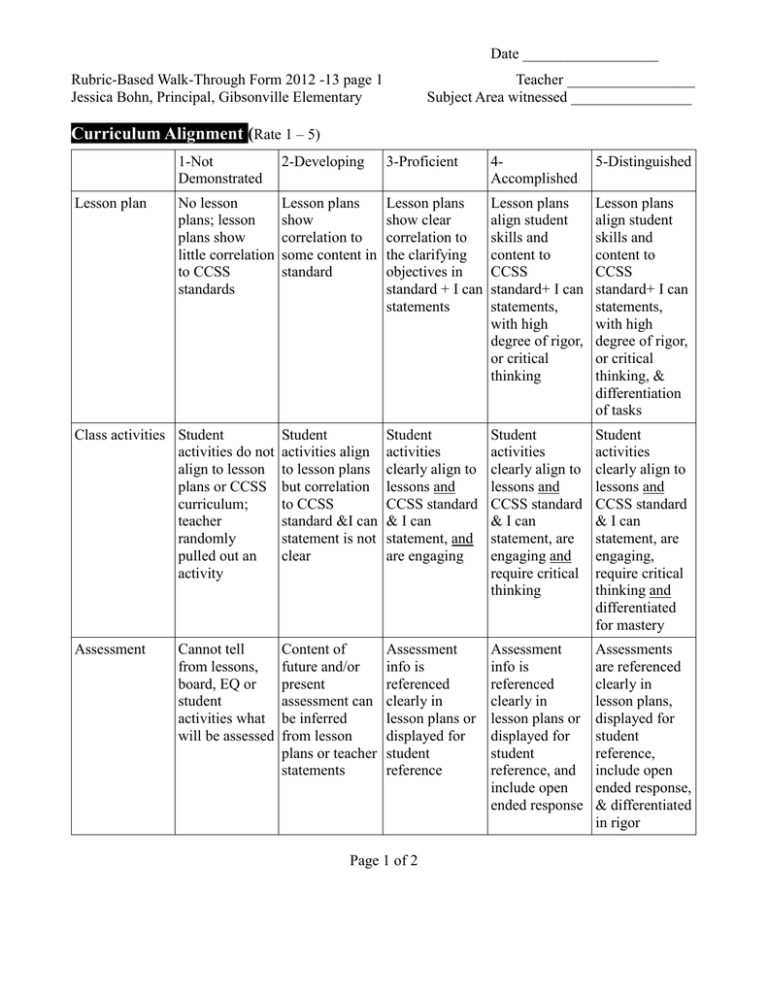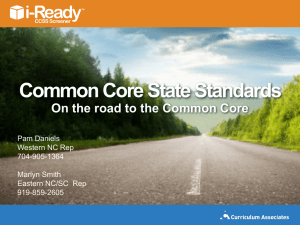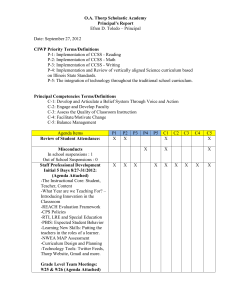
Date __________________
Rubric-Based Walk-Through Form 2012 -13 page 1
Jessica Bohn, Principal, Gibsonville Elementary
Teacher _________________
Subject Area witnessed ________________
Curriculum Alignment (Rate 1 – 5)
1-Not
Demonstrated
2-Developing
3-Proficient
4Accomplished
5-Distinguished
No lesson
plans; lesson
plans show
little correlation
to CCSS
standards
Lesson plans
show
correlation to
some content in
standard
Lesson plans
show clear
correlation to
the clarifying
objectives in
standard + I can
statements
Lesson plans
align student
skills and
content to
CCSS
standard+ I can
statements,
with high
degree of rigor,
or critical
thinking
Lesson plans
align student
skills and
content to
CCSS
standard+ I can
statements,
with high
degree of rigor,
or critical
thinking, &
differentiation
of tasks
Class activities Student
activities do not
align to lesson
plans or CCSS
curriculum;
teacher
randomly
pulled out an
activity
Student
activities align
to lesson plans
but correlation
to CCSS
standard &I can
statement is not
clear
Student
activities
clearly align to
lessons and
CCSS standard
& I can
statement, and
are engaging
Student
activities
clearly align to
lessons and
CCSS standard
& I can
statement, are
engaging and
require critical
thinking
Student
activities
clearly align to
lessons and
CCSS standard
& I can
statement, are
engaging,
require critical
thinking and
differentiated
for mastery
Assessment
Content of
future and/or
present
assessment can
be inferred
from lesson
plans or teacher
statements
Assessment
info is
referenced
clearly in
lesson plans or
displayed for
student
reference
Assessment
info is
referenced
clearly in
lesson plans or
displayed for
student
reference, and
include open
ended response
Assessments
are referenced
clearly in
lesson plans,
displayed for
student
reference,
include open
ended response,
& differentiated
in rigor
Lesson plan
Cannot tell
from lessons,
board, EQ or
student
activities what
will be assessed
Page 1 of 2
Date __________________
Rubric-Based Walk-Through Form 2012 -13 page 2
Gibsonville Elementary
Teacher _________________
Subject Area witnessed ________________
Student Engagement
Student
activities
1-Not
Demonstrated
2-Developing
3-Proficient
4Accomplished
5-Distinguished
Most students
are not on task
or are doing
something
other than
teacher
assigned tasks
Students are all
working on the
same worksheet
quietly; or
many students
are off task/ not
working on
assigned task;
Students are
receiving
lecture and
taking notes,
answering
questions,
working on
practice skills
independently
or reading
silently;
students are all
on task
Students are
asking critical
questions,
working
collaboratively,
participating in
project-based
learning or a
content-rich
game or
completing
visual/
kinesthetic
tasks; students
are all on task
Students are
working in
teams w/ clear
roles, projectbased learning,
visual or
kinesthetic
tasks integrated
w/ larger unit
themes &
activities are
differentiated
based on
learning styles
or 21st century
skills; all
students on task
1- Not
Demonstrated
2-Developing
3-Proficient
4Accomplished
5-Distinguished
Lesson plans
indicate
students will
always do the
same tasks for
all students
Based on lesson
plans and class
activities, some
students will
have varying
tasks, compared
to the rest of
the class
Based on lesson
plans and class
activities, it is
clear that there
is some
variation in
tasks for
different groups
of students.
Based on lesson
plans and class
activities, it is
clear that there
are several
activities for
different
students based
on: Skill,ability,
learning styles,
or choice
boards.
Based on lesson
plans and class
activities, it is
clear that there
are several
activities for
different
students based
on: skill,ability,
learning styles,
or choice
boards and
there are clear
degrees of rigor
for each and
alignment to
CCSS is
labeled for each
Differentiation
Activities or
lesson plans
Page 2 of 2
How to Start a Common Course
Jessica Bohn
Principal
Gibsonville Elementary
Guilford County Schools
bohnj@gcsnc.com
Where to Begin
• Understanding the new standards
• Understanding the ‘shifts’
• Understanding the pedagogy needed to teach for
new mastery
• Monitoring instruction as it relates to CCSS
implementation
• Provide feedback and opportunities for regular
professional dialogue about data, curriculum,
instruction & assessment
Understanding the new
standards
• Look for curriculum, instruction and
assessment alignment
• What do you do when you don’t know
what the assessments will look like?
Activity
The next two slides relate to an activity
centered on building teachers’
understanding of the concepts and core
content in the standards.
What does this CCSS ask students to
know and be able to do?
CCSS.Math.Content.4.OA.B.4 Find all factor pairs for a whole
number in the range 1–100. Recognize that a whole number is a
multiple of each of its factors. Determine whether a given whole
number in the range 1–100 is a multiple of a given one-digit
number. Determine whether a given whole number in the range 1–
100 is prime or composite.
Deconstruct the standard into a task
analysis. Use the provided handouts.
What does this CCSS ask students to
know and be able to do?
• CCSS.Math.Content.7.RP.A.2d Explain what a point (x, y) on
the graph of a proportional relationship means in terms of the
situation, with special attention to the points (0, 0) and (1, r)
where r is the unit rate.
Deconstruct the standard into a task
analysis. Use the provided handouts.
Leading the Change
• Principals and APs must lead the change by
designing school-based professional development
that:
– Allows teachers to articulate, construct and plan activities
that truly relate to student expectations in CCSS
– Engages them with interactive activities that model the
instructional and assessment planning processes
– Demonstrates what 21st century learning looks like when it is
directly correlated with the standards and not taught in
isolation
Leading the Change
• Teachers must be engaged in PLCs
that focus on student data and the
instructional response to that data
• Helping teachers understand how to
make sense of data is vital
• See the handouts: Benchmark Analysis, PLC
Guide K-2 and PLC guide 3-5
Monitoring the Change
Walkthroughs provide great data, when:
- data is collected
- the instrument used is designed to
capture the correct focus, instructionally
- feedback is given to teachers
- data from walkthroughs is used for
administrative planning
Activity - Walkthroughs
• With your group, discuss and log on the
chart paper given to you: What kind of
information is ‘looked for’, collected and
used?
• If you are a teacher, what kind of
feedback do you receive and is it
useful?
Customizing Walk-throughs
• My rubric-based walk-through
instrument
– Why (shortfalls of instruments, SIP goals)
– How developed
– How used
– How to improve it
Activity - Lead the Change
Principals, Assistant Principals and Lead
Teachers must “Lead the Change”. They
must become masters of professional
development.
What have you done and what will
you do to lead the change? This is
an individual task that will be partner-shared.
Contact Info:
Jessica Bohn
bohnj@gcsnc.com
Principal
Gibsonville Elementary
Common Core Lesson Planning Template
Grade Level (circle): K 1
2
Content Area
Reading
Writing
Science
Technology
(Shared/Integrated)
Math
SS
3
4
5
Teacher/Room:
Speaking/Listening
Language
Morning Meeting
Word Work
Practical Living
Arts/Humanities
Foreign Language
Library
[Check all that apply]
Day 1
Day 2
Standard(s):
Day 3
Standard(s):
Day 4
Standard(s):
Standard(s):
I CAN(s):
1.
I CAN(s):
1.
I CAN(s):
1.
I CAN(s):
1.
I CAN(s):
1.
2.
2.
2.
2.
2.
3.
3.
3.
3.
3.
Academic
Language/Vocabulary:
Academic
Language/Vocabulary:
Academic
Language/Vocabulary:
Academic
Language/Vocabulary:
Academic
Language/Vocabulary:
Standard(s):
Day 5
Essential Question for Unit:
Performance Task:
Common Core Lesson Planning Template
___Whole ___Guided ___Ind.
Teaching Strategies:
___Whole __Guided ___Ind.
Teaching Strategies:
___Whole __Guided ___Ind.
Teaching Strategies:
___Whole __Guided ___Ind.
Teaching Strategies:
___Whole __Guided ___Ind.
Teaching Strategies:
Resource/Materials/Pg:
Resource/Materials/Pg:
Resource/Materials/Pg:
Resource/Materials/Pg:
Resource/Materials/Pg:
Differentiation check):
Differentiation check):
Differentiation check):
Differentiation check):
Differentiation(check):
Content
Description:
Process
Product
Content
Description:
Process
Product
Content
Description:
Process
Product
Content
Description:
Process
Product
Content
Description:
Process
Assessment
Summative
Formative
Assessment
Summative
Formative
Assessment
Summative
Formative
Assessment
Summative
Formative
Assessment
Summative
Formative
Description:
Description:
Description:
Description:
Description:
Integration:
Integration:
Integration:
Integration:
Integration:
Media Skills
Media Skills
Media Skills
Media Skills
Media Skills
Research
Research
Research
Research
Research
Other:
Other:
Other:
Other:
Other:
Description:
Description:
Description:
Description:
Description:
Product
Standards for deconstruction for CCSA Activity
CCSS.Math.Content.4.OA.B.4 Find all factor pairs for a whole number in the range 1–100. Recognize that
a whole number is a multiple of each of its factors. Determine whether a given whole number in the
range 1–100 is a multiple of a given one-digit number. Determine whether a given whole number in the
range 1–100 is prime or composite.
What do students need to know?
What do students need to be able to do?
Steps to understanding:
What does this look like in the real world?
Use real world connection to develop an idea for hands-on, investigative, manipulative or project-based
component?
How can this concept be integrated with other subject areas?
How can this concept be assessed with performance-based, visually represented or technologyenhanced items?
Standards for deconstruction for CCSA Activity
CCSS.Math.Content.7.RP.A.2d Explain what a point (x, y) on the graph of a proportional relationship
means in terms of the situation, with special attention to the points (0, 0) and (1, r) where r is the unit rate.
What do students need to know?
What do students need to be able to do?
Steps to understanding:
What does this look like in the real world?
Use real world connection to develop an idea for hands-on, investigative, manipulative or project-based
component?
How can this concept be integrated with other subject areas?
How can this concept be assessed with performance-based, visually represented or technologyenhanced items?
More Sharing
ServicesShare | Share on
facebook Share on
twitter Share on email
Teacher Evaluation: What's Fair? What's Effective?
November 8, 2012 | Volume 8 | Issue 3
Table of Contents
Field Notes
Setting a Common Course
Jessica Bohn
As districts and states prepare to implement Common Core curricula, instructional leadership is perhaps the most
important area to affect student learning. Knowing how to implement, monitor, and assess a new curriculum can be
daunting for any leader. How can principals ensure that teachers know and understand the content of the new
curriculum? How can they effectively monitor delivery of the new curriculum in a meaningful way? The following tips,
from a school principal in a state that has fully implemented the Common Core State Standards, can help.
1. Task Analysis
Principals should have their teachers break down the standards into meaningful skills or steps for mastery. For
teachers to fully understand how to teach the new curriculum, they must understand what the standard is expecting
students to know and be able to do. This means that teachers must have an in-depth knowledge of the competencies
required by each standard, in terms of student learning. Educators must also understand the level of rigor required at
each grade level within each domain.
To do this, teachers should create a task analysis for each standard and then look at each task analysis vertically
(from grade to grade) and compare. A task analysis is the series of steps or concepts that students need to be able to
do or understand to master the standard. For example, to master rounding to the nearest one hundredth, students
have to first understand the concepts of place value, decimals/fractions, and greater than/less than. Subsequently,
teachers can compare the domains vertically; for example, how does teaching rounding or regrouping look different
from 3rd to 4th to 5th grade? This level of detailed analysis will provide an aligned curriculum to ensure student
learning and student success. These actions are supported by the concepts outlined in the book Total Instructional
Alignment by Lisa Carter.
2. Monitoring Tool
Rationale
Principals need to monitor instruction in a way that provides useful information to teachers, administrators, and the
entire staff collectively. Conducting walk-throughs is a typical part of any school principal's duties as an instructional
leader, but conducting walk-throughs without collecting data or providing feedback accomplishes no more than
making an appearance in a classroom.
Although many wonderful tools are available aimed at capturing what is seen in the classroom, it can be difficult to
know which tools will be most effective. The effectiveness of walk-through tools is something that concerns Robert
Page 1 of 2
Marzano, who says in his video "Why Most Classroom Walk-Throughs Are Ineffective," "The walk-throughs I've seen
focus on typically a very narrow range of instructional strategies." I believe that principals should develop their own
walk-through tools, with input from teachers. We know that performance is enhanced when individuals have input
about what the end product should look like. This is true for teachers and for students. When students are involved in
creating a rubric to be used in the final grading of a project, they are more likely to perform better. Similarly, when
teachers are involved in creating a tool for assessing walk-throughs, they tend to perform at the higher end of the
standards in the walk-through instrument. What type of tool should principals begin with? This should be informed by
the school's improvement plan and the data needed to support the school's mission.
The Instrument
I have seen many walk-through forms, look-for documents, and checklists that can be used to capture teaching and
learning. I was never satisfied with any of them, particularly regarding what I needed to move my teachers to the next
level. I felt as though many of the areas assessed required yes or no responses, rather than asking me—as an
instructional leader—to assess the quality of teaching and learning. For example, one particular instrument had
checkboxes for whole group, small group, cooperative learning, leveled readers, manipulatives, and so on. I found
that the instrument did not provide my teachers or me with enough information. School leaders know that the use of
manipulatives can vary greatly in quality of learning from classroom to classroom. Simply checking off "use of
manipulatives" does not provide enough meaningful information.
Quality of Information
To be able to collect more qualitative data from my walk-throughs, I created a rubric-based instrument (PDF) that
focused on only three key areas: A) student engagement, B) Common Core curriculum alignment, and C)
differentiation. We chose these three areas as the focal points for our new instrument based on our school
improvement plan and data from student surveys and informal walk-throughs. Within these three areas (A, B, and C),
we defined five levels of competence: not demonstrated, developing, proficient, accomplished, and distinguished.
Although these descriptors correlate to our state's teacher-evaluation instrument, they are meant to capture the level
of performance within each of the three focal areas described. In the rubric, we then described indicators of what
each level of performance looks like for each of the three focal areas.
Use of Walk-Through Data
When conducting walk-throughs, I circle the most appropriate level of performance in each of the focal areas. Both
the teacher and the administrator receive a copy. Additionally, we can use the data (omitting teacher names) to see
where we are schoolwide regarding student engagement, Common Core instruction, and differentiation. We then use
this data to identify potential professional development needs for our staff.
When implementing Common Core curriculum, principals should delve into the curriculum with their teachers and
employ creativity when developing their own instrument to capture instructional walk-throughs.
Resource
Robert Marzano's Videos: www.iobservation.com/Marzano-Suite/Videos/why-most-classroom-walk-throughs-areineffective
Carter, Lisa. Total Instructional Alignment. Phoenix: All Star Publishing, 2004.
Jessica Bohn, a principal in North Carolina, has formerly served as assistant principal, district curriculum specialist, science
teacher, and assistant director at a university. She is passionate about STEM education and 21st century learning. Bohn is a
member of ASCD's 2012 class of Emerging Leaders.
ASCD Express, Vol. 8, No. 3. Copyright 2012 by ASCD. All rights reserved. Visit www.ascd.org/ascdexpress.
Page 2 of 2
Professional Learning Communities Weekly Question Guide
Date: ______________________
Grade Level _____
PLC Time/Focus Keeper ___________
PLC Facilitator ______________
Members Present: ____________________________________________________________________
Questions for Discussion:
1.
What does the data say about where the students are now, in terms of their understanding of the major
objectives taught last week? (You can break down in terms of % mastery of skills by
Reading:
a. ___% do not have ______________________________________ skill
b. ___% have ______________________________________ skill but not independently
c. ___% have ______________________________________ skill independently
Math:
a.
b.
c.
2.
___% do not have ______________________________________ skill
___% have ______________________________________ skill but not independently
___% have ______________________________________ skill independently
What are the new curriculum and/or unit objectives to focus on this week:
Reading:
Math:
3.
How will we reinforce skills in items ‘a’ and ‘b’ above and teach new skills to ‘b’ and ‘c’, to meet all
students on the learning continuum? (i.e. how will you differentiate for this?)
4.
What are any obstacles that will be presented this week, in terms of teaching the necessary skills?
5.
What instructional strategies will we use to accomplish the curriculum goals established above? (List
strategies you will use as a team in your lesson plans. You should also collaboratively discuss lesson plans.)
6.
What other grade level instructional items need attention this week (miscellaneous)?







